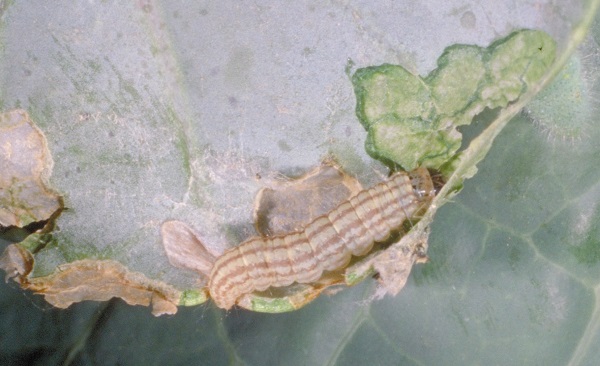Cabbage Webworm
ENTFACT-315: Cabbage Webworm | Download PDF
Ric Bessin, Extension Specialist
University of Kentucky College of Agriculture
There is another southern pest that occasionally makes its way into eastern Kentucky in the fall. It is the cabbage webworm. This insect is common along Gulf Coast and southern Atlantic Coast states but only rarely moves into Kentucky. This pest attacks cabbage, broccoli, cauliflower and other crucifers. Producers should monitor for this insect along with imported cabbageworm, diamondback moth, cross-striped cabbageworm and cabbage looper.

Figure 1. Cabbage webworm is uncommon but can occur in Kentucky.
The cabbage webworm is easily recognized. Unlike other caterpillar larvae that attack cole crops in Kentucky, this larva has a black head capsule. The larvae are tan colored with four brown stripes running the length of the body.
The larvae are often found inside webbed pockets formed along the leaf margins. Initially damage appears as small (size of a US quarter) brown, dried areas along the leaf margins.
The moth has brownish-yellow forewings mottled with darker brown and pale gray hind wings. Resting on the ground where it is well camouflaged, the moth takes short, erratic flights when disturbed. Cabbage webworm moths deposit approximately 300 to 350 eggs on host plant buds. About 3 days later, larvae emerge and feed in the buds, eventually moving to the outer leaves where they spin webs and continue to feed along large leaf veins. They pupate among shed leaves or other refuse on the ground.

Figure 2. Cabbage webworm, webbing, and damage.
Unfortunately, this pest is more destructive than the other lepidopterous pests of cabbage, particular on small plants. Other caterpillar pests are generally leaf feeders, although some do prefer the young leaves near the bud. Many of the cabbage webworm larvae will feed on the leaf margins by webbing the leaf margin back on itself to form a pocket on the underside of leaves in which it feeds. Some of the cabbage webworm cause extensive damage when they bore through the bud and into the stem of the plant. This can kill the bud and cause lateral budding. This prevents the plants from developing marketable heads. They sometimes kill the entire plant.
Management
Because this is typically an Atlantic coast and southern pest, this insect is not a problem with spring crops. Producers need to begin monitoring when fall plants are first set into the field. Fall cole crop producers in the Atlantic coast states spray preventively for this pest after plants are set into the field. Controls used for other cabbage pests are effective against cabbage webworm when timed properly. Sprays should be applied while the larvae are small before they construct their protective silken webs. Once inside the folded leaves the larva are protected from insecticide sprays. Sprays need to be directed underneath the leaves and down into the bud.
Revised: 11/19
CAUTION! Pesticide recommendations in this publication are registered for use in Kentucky, USA ONLY! The use of some products may not be legal in your state or country. Please check with your local county agent or regulatory official before using any pesticide mentioned in this publication.
Of course, ALWAYS READ AND FOLLOW LABEL DIRECTIONS FOR SAFE USE OF ANY PESTICIDE!
Photos courtesy Ric Bessin, University of Kentucky Entomology
